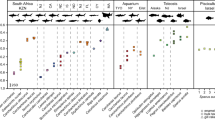Abstract
MAURICE Lariche1 states that the teeth of the gigantic extinct shark, Carcharodon megalodon, found on the bottom of modern oceans belong to the Pleistocene period. The report of the Challenger Expedition2 states that some shark teeth from the same station were covered with a layer of manganese dioxide—one slightly, another deeply. Among them at Station 281, depth 2,385 fathoms, South Pacific, were found teeth of Carcharodon megalodon. Knowing even approximately the thickness and rate of growth of the manganese dioxide layer, we should be able to establish the geological age of embedded teeth much more exactly than before. According to Hans Pettersson3 the growth-rate is 0.15 mm.−1.4 mm. every 1,000 years and on the upper surface of manganese dioxide nodules it is about 1½ times greater than on the lower.
Similar content being viewed by others
References
Maurice Lariche, Mém. Musée Roy. D'Hist. Nat. Belgique. 12th Ser., 3 (1936).
Report on the Scientific Results of the Voyage of H.M.S. Challenger during the years 1873–76. ‘Deep Sea Deposits’ (London, 1891).
Hans Pettersson, ‘Papers in Marine Biology and Oceanography’. Vol. 3 of ‘Deep Sea Research’ (Penguin Press, London and New York).
Ridgeway, ‘Colour Standards and Nomenclature’ (Washington, 1912).
Author information
Authors and Affiliations
Rights and permissions
About this article
Cite this article
TSCHERNEZKY, W. Age of Carcharodon megalodon?. Nature 184, 1331–1332 (1959). https://doi.org/10.1038/1841331a0
Issue Date:
DOI: https://doi.org/10.1038/1841331a0
- Springer Nature Limited





